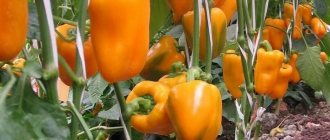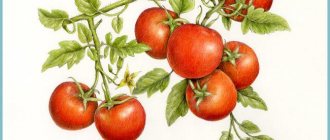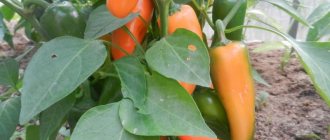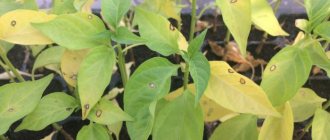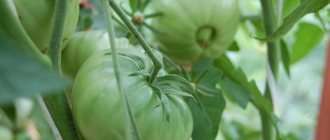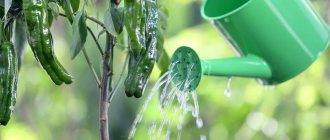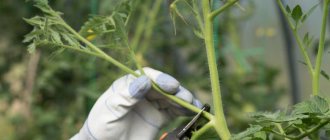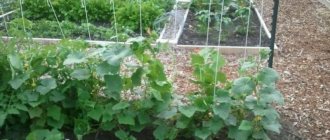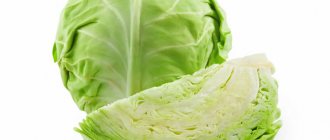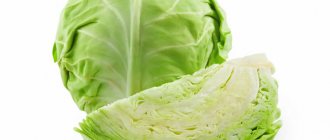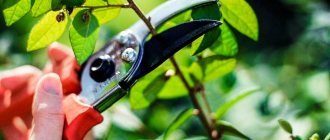To obtain a good harvest, it is important to shape the bell pepper. Read more in the article.
According to experienced summer residents, the process of plant formation is the main way to increase the yield and size of future fruits. Novice vegetable growers extremely rarely use this technique, believing that the plant will give a good harvest without the formation procedure, and that it is possible to get by only with watering and fertilizing. However, shaping is not a single procedure involving cutting and pinching. This process has a large number of stages and includes many techniques.
Read another article on our website on the topic: “What can you cook from bell peppers for the winter?” . You will find recipes for preparing sweet bell peppers for the winter. You will also find tips on drying, freezing, and pickling. This article also contains the best recipes for preparing stuffed vegetables, fried bell peppers, in tomato-garlic sauce, caviar, lecho, and adjika from bell peppers for the winter.
A pepper bush, formed according to all the rules, will have a beautiful appearance and will be able to please the vegetable grower with a good harvest. How to do this correctly, read on.
Varieties of bell pepper: features of their formation
Bell pepper
When starting to form bell pepper, it is worth considering the characteristics of each variety. Here is a list of them and the features of their formation:
- Tall pepper : when shaping, it is necessary to carry out the pinching procedure, as well as cut off shoots that are unnecessary and that interfere with growth.
- Medium-sized pepper : it is important to remove fruitless side shoots. This will increase the light supply and allow air to circulate around the plants more well.
- Low-growing and dwarf peppers : these types do not require special shaping. When growing them, it will be enough to remove weak shoots without fruits.
Pinching the crop must be done very carefully. Follow all rules.
Watering peppers
Watering is done on top of the mulch layer; there is no need to move it away. It retains moisture well and prevents its rapid evaporation from the surface. The soil will remain loose, breathable, and a crust will not form on it.
Watering in the greenhouse should be done every 3-4 days. If peppers grow in open ground conditions, then water the plants more often. When the soil around the plant dries out greatly, the pepper reacts to the lack of moisture by dropping flowers. Overfilling is just as dangerous as underfilling. Follow moderation when watering peppers and always take into account weather conditions and the characteristics of your climate.
Rules for forming bell peppers
In order to reap a rich harvest of bell peppers in the future, you need to know the rules of formation:
- Low-growing varieties must be allowed to grow freely.
- There should be few ovaries, then the size of the pods will increase.
- Pinching increases the speed of ripening.
- Do not leave stepchildren until the first fork is pecked.
- Remove all shoots directed into the bush.
- When forming a bush, it is worth leaving 2-3 trunks.
- Frame shoots should grow freely.
- The blind branches above the ovaries must have 1-2 leaves to receive nutrition.
- Tall varieties need to be tied up (each shoot separately).
- The fruits on the frame branches should be distributed evenly.
The shoots should be removed when this can be done without injuring the bush itself.
Cutting leaves from peppers
When you notice that the top of the trunk has begun to double, triple, or form more branched combinations, this is a signal that it is time to cut off the lower leaves. There is no need to remove all the leaves in one fell swoop. Such extreme exposure can cause stress in the plant, delay the development of the bush and lead to shedding of buds.
Remove no more than 2-3 leaves at a time. The frequency of cutting is once every 5-7 days. As a result, the stem up to the central fork should be left absolutely without leaves and stepsons. This formation will allow air to circulate freely between the bushes, provide ventilation and, accordingly, will become a preventive measure against the development of fungal infections, diseases and will prevent insect pests from breeding in the “shady canopy of the branches.”
Methods for shaping bell peppers
There are several different ways to shape bell peppers:
- Removing inflorescences : growing to 20-25 cm , the skeletal stem begins to branch. Buds grow in the bifurcation area. They must be removed for the further, correct branching process.
- Pinching shoots : a proper bush should have a stem and a couple of strong shoots coming from the inflorescence. Other branches should be removed by pruning.
- In one stem : when the bushes are located at a small distance from each other, the crops are able to unite into one stem. In such a situation, it will not be possible to harvest from large bushes, so they need to be discharged to improve ventilation and nutrition of each plant.
If the first two methods are clear, you need to remove the buds or pinch the shoots. The process of formation “ into one stem ” is not always clear, especially to novice gardeners. It looks like this:
- The first stage should begin when branches arise.
- All growing shoots are pinched; only the main stem on which the ovary is located needs to be preserved.
- Fresh forks that appear on the skeletal stem should also be removed.
- After 12 fruits ripen on the bush, pinch the crown.
Method for forming bell peppers
There is one more method - “in two stems”. This is the most common forming option. As a result, the plant should have a V-shaped design . This method allows you to collect about 25 fruits from 1 plant. The process has the following sequence:
- The skeletal growth of the first order grows into 2 processes of the second order. The strongest shoot is left untouched. It will support other processes located above and is considered skeletal. Leave buds with leaves on this shoot. The second process is usually weaker. Pinch it off, keeping the fruit with leaves.
- The main shoot of the second order is divided into two processes, which will have a third order. It is also necessary to isolate the skeletal process from these branches. He will develop and grow well. In the axils of the leaves of the main shoot, remove all the stepsons. In addition, all yellowed leaves should be removed from the main branches. Pinch the weakest third-order shoot at the top, where the flower bud is located. It is imperative to leave one leaf, which will nourish all the ovaries.
- A similar process is carried out with the first-order skeletal process of the second branch (1st fork). The bush is divided into two stems. If you keep two side shoots on the trunk instead of one, then you will get 4 main branches. One needs to be cut off.
- After 20-26 fruits ripen on the bush, cut off the tops of the plant.
- After cutting off the top, the nutrients will be redirected to the young ovaries.
Another popular way of forming “in three stems” :
- To grow three-stem peppers, you need to have a large greenhouse, but this method will bring the richest harvest.
- With this planting option, each bush receives maximum nutrition and lighting.
Choose the most suitable method for yourself. The formation stages are described below. Read on.
The meaning of the procedure
Pinching seedlings is important for the formation of healthy plants. The procedure involves shortening the central stem. It leads to thickening of the shoots, as well as an increase in the size and number of leaf plates.
Pinching, or pinching, is the removal of shoots on plants, helping to regulate crown growth. Various crops are subjected to the procedure, including peppers and tomatoes. This helps to increase the number of ovaries and activates their growth. As a result, the yield from each plant increases. Nutrients are spent not on the growth of seedlings, but on the ripening of fruits.
Peppercorns have several benefits:
- Vegetables grow larger in comparison with the harvest on plants that have not been pinched. The walls of the fruit are thicker, denser, and stronger.
- After pinching, the root system of seedlings develops more actively, so that they receive more moisture and nutrients from the soil.
- Fruit buds grow faster after pinching peppers, so ripening occurs earlier.
- Caring for pepper seedlings becomes easier. It is easier to loosen the soil, treat plants from pests, and apply fertilizers thanks to easy access to the plants.
- Pinching reduces the risk of developing fungal infections that can cause black rot in fruits.
Peppers that have been pinched become more resistant to various types of mosaics.
Important! Diseases caused by thickening of bushes develop on seedlings and adult specimens extremely rarely. These include gray rot, bacterial infections, and alternaria.
Stages of formation of bell pepper: diagram
When forming a plant using the stem method, you need to install trellises so that branches of all orders are attached to the transverse fasteners. Here's the diagram:
Stage of formation of bell pepper
Remember: A large number of fruits can break thin branches.
Low-growing, hybrid and weakly branching varieties do not require formation.
Worth knowing:
- Perform processing when the first branches appear.
- In cases where the number of sprouts that appear is more than 3 , the excess ones are removed.
- If the number of shoots on a branch is less than 3 , then you need to leave the lower shoots on the skeletal stem. When they grow, keep the strongest one and remove the rest.
- After a fork appears on the stems of the first order, all weakened, thin shoots are cut off and one, stronger one is left.
- The cut should be repeated for the main branches of new orders until 25 to 30 fruits .
- Then cut off the top of the plant to remove the growing point. This will give the bush the opportunity to form a rich harvest.
On the main stems of all orders, new leaves and ovaries may soon appear. They need to be cut off gradually. First, those leaves that shade the ovaries must be removed. This procedure must be repeated until the bush grows to a height of one meter. So that there is no more growth, and the beneficial substances go to the lower fruits and ovaries, the top is cut off. In 1.5 months. Before harvesting fruits, the top of the main branches of all orders must be cut off so that beneficial microelements are redirected to the lower fruits.
Worth knowing: On formed bushes of plants, about 20-25 large, thick-walled fruits are usually preserved. With the onset of autumn, a large number of small ovaries and fruits will appear on unformed bushes.
Remember:
- When growing peppers in the garden - in the open air, and not in greenhouse conditions, you need to form only tall varieties.
- For a medium-sized species, only barren shoots with stepsons need to be removed to provide the bushes with sufficient oxygen and light.
- The low-growing species does not need to be processed.
Important: All inward growing, broken and crooked processes are subject to the removal procedure. Bushes of medium-sized and low-growing peppers need pinching of the central shoots to enhance lateral branching.
Stages of formation of bell pepper - sequence:
- As soon as the pepper gets stronger and reaches a height of 25-30 cm , it is necessary to remove all the primary buds.
- In addition, cut off the buds on the side shoots, this will stimulate the growth of additional branches. The seedlings will begin to bush.
- All subsequent shoots should be formed in the same way: remove the stems and leave 3-5 branches .
- On the skeletal process, before the first fork, remove shoots and leaves.
- All main trunks should be pruned at the point of growth after a large number of fruits have appeared.
- Perform the final pruning procedure several weeks before the end of fruiting.
The total number of fruiting shoots should not be more than 4-6 pieces, and 15-25 .
What techniques are used
When forming a bell pepper bush according to any scheme, the same techniques are used. This is pinching, pinching, pruning. It is important to know where and on which branches each technique is needed.
Stepsoning
A stepson is a shoot formed in the axil of a leaf or at the base of a formed shoot. Stepchildren must be removed completely, leaving a “stump” of no more than three millimeters. As a rule, these are weak branches that will not produce normal fruits. If you leave them, the plant will spend extra energy, which it could direct to full-fledged peppers. There is no need to plant dwarf and ornamental varieties.
Topping
Pinching allows you to stop further development of the shoot by removing the growing point. This eliminates unnecessary side branches. Pinching is carried out taking into account that the ovary and one or two leaves should remain on the shoot. You cannot leave only the flower bud and remove all the leaves. In this case, the plant will not have enough strength to set fruit.
You need to pinch out shoots of the second and third order, forming a neat, well-fruiting bush. In the same way, the growth points of all shoots are removed when the required number of fruits on the plant is reached.
Trimming
Pruning involves removing parts of the plant using special tools (garden shears, knife, pruning shears...). What to trim from peppers:
- shoots and leaves below the first fork;
- barren, “fat” branches;
- diseased, twisted shoots inside the crown;
- too densely growing leaves that interfere with the penetration of light.
You should also trim the first, royal bud. It forms in the middle of the first fork; if left, it will produce the largest pepper, but will take a lot of effort to form the remaining fruits. It is advisable to leave the royal bud to obtain seeds - in it they ripen healthy and full-fledged.
Greenhouse growing of bell peppers: principle
When transferring seedlings to a greenhouse, they must be planted in such a way that there is always space to increase the volume by several bushes. The planting scheme for the most bushy species can be 5-6 pieces per square meter. With average bushiness, plant 6-8 bushes per meter.
Greenhouse growing of bell peppers
The principle of greenhouse formation of bell pepper is to rid the plant of barren shoots:
- After the plant has taken root at the planting site, it must be constantly inspected and treated for parasites.
- Barren shoots growing on the trunk before the first fork begins should be removed to provide the bushes with good lighting and air circulation.
Greenhouse pinching of bell pepper
Pepper shoots that appear after branching are called lateral shoots . These processes are skeletal. Each of these shoots initially grows as a central stem with leaves. Subsequently, new shoots, called stepsons . These shoots must be removed by pinching.
Increasing the harvest of peppers in the greenhouse
Sometimes pollination goes poorly. Pollen does not fall from the anthers to the stigmas. In this case, ovaries are not formed. To prevent this from happening, apply a few simple rules:
- Shake your pepper bushes regularly. This simple action will increase the pollination of plants. After all, when shaking, the pollen will better come out of the anthers and land on the stigmas of the flowers.
- Ventilate the greenhouse or greenhouse. Air currents carry pollen from flower to flower just as well as pollinating insects.
- Use agricultural products. There are special products that will help improve the yield of peppers. These include the drug "Ovary". Use it according to the instructions to solve the problem of poor pollination of garden crops.
Mistakes when forming and growing bell peppers
The formation of a bell pepper bush actually begins with the planting process. A gardener must know not only how to prune or pinch a bush, but also how to properly plant, fertilize and water plants. Here are the mistakes when forming and growing bell peppers:
- Violation of planting deadlines : pepper seedlings need to be planted only after the threat of return of spring frosts has disappeared, otherwise the plant may die. According to reviews from experienced vegetable growers, in the middle zone, seedlings begin to be planted in open ground in late May - early June. You can plant seedlings in closed structures already at the end of April, and in heated greenhouses - in mid-March.
- Excessive nutrition with fertilizers : at the beginning of the growing season, like other nightshade crops, pepper needs nitrogen fertilizing. However, you should not overdo it with fertilizers, because overfeeding leads to excessive formation of useless green mass. You need to water the seedlings once, after rooting. As a fertilizer, you can use a weak solution of urea (one dessert spoon per 10 liters of water) or a weak solution of slurry (1:10).
- Violation of the temperature regime : if the bushes have many peduncles, but ovaries do not form at all, then the plant is experiencing problems with pollination. This can occur due to high air humidity, for example, in a greenhouse, as well as sudden temperature fluctuations. Heat and cold are equally harmful to plants. It is necessary to reduce watering, constantly ventilate closed structures during hot weather and heat during cold weather. It is necessary to treat the seedlings with preparations that improve the appearance of ovaries.
- Improper watering : both deficiency and excess of water in the soil are equally harmful. When watered with ice water or the soil dries out, the ovaries and flowers begin to fall off en masse. Plants need to be watered with settled water, heated once every 3-7 days, when 2-3 cm of the top layer of soil has dried.
- Inadequate nutrition : A lack of minerals such as calcium, magnesium and potassium combined with cold weather can lead to the formation of fruit rot. Ripening fruits on diseased plants begin to rot at the point where the stalk attaches. During cold summers, you need to use foliar feeding with the addition of phosphorus-potassium fertilizers.
- Cross-pollination of sweet and savory varieties when they are in the same greenhouse.
- Long exposure of seeds in potassium permanganate : this substance removes all harmful microorganisms from this material well. However, too strong a solution and too long exposure of the seeds can lead to combustion of the material.
Experienced vegetable growers advise using a solution of no more than 0.5 percent strength and keeping the seeds in it for no longer than 25 minutes. To prepare such a solution, you need to dilute 0.5 teaspoon of manganese in 600 milliliters of water.
When to form a bush
The formation of a crop begins not when the bush reaches a certain height, but after the formation of the first fork. If you wait for low-growing, thick-walled varieties until they grow to 25 cm, declared by some sources, you can collect the first ripe pods at the same time as they begin to form. And on indeterminate ones, and with elongated seedlings, it can cause excessive branching and significantly delay harvesting, since the fork has not yet appeared.
They begin to form peppers after moving them to open ground or a greenhouse; when they take root, new leaves will appear. If the seedlings have overgrown and a fork has appeared earlier, you should wait until planting so as not to weaken the bush - any removal of vegetative organs is stressful.
Pests of bell pepper
Pests of bell pepper
Dangerous pests for bell pepper are whiteflies, thrips, and May beetle larvae. Greenhouse plants are most often attacked by aphids. Fertilizing and adding potassium-phosphorus fertilizers to the soil are very helpful in controlling pests. In addition, drugs created on the basis of quickly decomposing biological toxins or viruses that kill parasites have a good effect. Such substances are safe for humans and plants. Spraying crops to get rid of pests is best done exclusively in the morning.
- Bell pepper is a very smart crop.
- Therefore, by carefully observing it, you can quickly understand that the plant is sick.
- The main signs of the disease are: discoloration and yellowing of leaves, fading.
- A timely reaction and subsequent care of the plant will allow it to quickly recover and continue to bear fruit.
During flowering and budding, you need to add plant ash in the amount of 1-2 cups per linear meter (before watering). You can additionally treat plants with drugs that increase stress resistance and immunity, for example: Zircon, Ecoberin, Silcom. This procedure should be performed in the morning, having prepared the solution in advance, following the instructions on the package.
Proper care of peppers after formation
Bell pepper when properly formed
Formation is a serious stress for the plant due to the fact that many leaves and shoots are removed from it. After this process, the plant requires high-quality and proper care to restore and continue growth:
- First of all, the pepper must be tied to a support so that its branches do not break under the weight of the fruit.
- Constantly spray the crop with warm water.
- Water in the early morning or late evening.
- The following waterings must be combined with the process of applying fertilizer.
By following the advice and recommendations of experienced gardeners, you can avoid the most common mistakes when growing bell peppers. Good luck!
Mulching peppers
Mulching involves covering the root zone of plants with a layer of mulch. Various materials can be used as mulch: spunbond, agrofibre, hay, straw, mown grass, chopped bark, sawdust. Spread the mulch evenly over the entire bed, leaving some free space near the stems of the plants. The layer thickness should be at least 5 cm and no more than 10 cm. When using materials of natural origin, mulch must be added regularly throughout the season. Why is it important? The reason is that soil biota quickly decomposes and is recycled. Consequently, the layer of mulch will become thinner and will perform its function worse - retain moisture at the roots.
